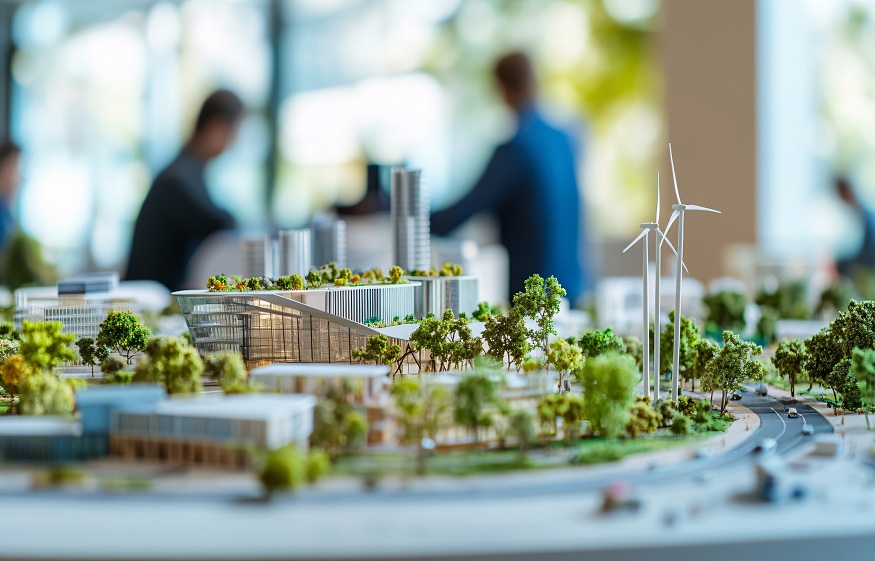The Hidden Strength of Expanded Polystyrene in Sustainable Design

Engineers collaborating on sustainable architecture model with wind turbines, solar panels, and green building design in office
Expanded polystyrene has a negative reputation. A lot of people look at those white foam containers and think about the environmental damage they cause. However, this misunderstood material is now a sustainability leader. Architects, engineers, and designers use foam for energy efficiency, waste reduction, and green buildings.
The Efficiency Champion
Consider your monthly electricity statement. Now, envision splitting it in two without altering your lifestyle. That’s the kind of power foam brings to building design. Foam acts as an extremely thick winter jacket for structures. It prevents warmth from leaving in winter and retains cool air indoors in summer. A slim layer of foam insulation performs the same function as a thick brick wall while being almost weightless.
Buildings use about 40% of America’s total energy. The majority of that is allocated to heating and cooling. Improved insulation results in reduced heating and cooling systems. Smaller systems consume less energy and produce fewer emissions. It’s a mutually beneficial scenario that begins with these white foam beads.
Strength That Surprises
People are often surprised to discover that foam is surprisingly strong, despite its lightness. A foam block that has the same weight as a smartphone can bear the weight of a vehicle. Engineers appreciate this strength-to-weight ratio as it creates design opportunities that previously appeared unattainable.
Foam foundation systems can sustain entire homes while being much lighter than concrete options. This is important because lighter structures require less substantial foundations. Reduced foundations result in minimal digging, decreased concrete use, and lower environmental effects during construction.
The material is more effective at managing earthquakes compared to heavier options. It bends instead of breaking. This adaptability protects structures and lives while lessening the necessity for repairs and reconstruction following catastrophes.
The Recycling Revolution
Used foam can be reused instead of being discarded in landfills. Intelligent recycling initiatives transform past packaging into future construction materials. Discarded foam is melted and remade into various items. Some recycling initiatives function similarly to foam repositories. Construction firms rent foam molds for pouring concrete, then return them for use in upcoming projects. This sharing system reduces waste and saves money for all participants.
Advanced recycling methods disassemble foam into its fundamental chemicals and subsequently reconstruct it into new items. This procedure can be repeated multiple times without diminishing quality. It’s akin to granting foam countless lives.
Smart Design Applications
Contemporary architects utilize foam in ways that would have appeared insane two decades ago. Walls made of foam concrete are created to offer insulation and structural support at the same time. Decorative foam panels offer both beauty and energy savings.
Expanded polystyrene insulation systems now incorporate smart home technology. Sensors track temperature and humidity, modifying building efficiency instantly. According to the people at Epsilyte, some systems are capable of producing their own electricity through integrated solar panels.
Conclusion
Sustainable design goes beyond merely using eco-friendly materials. It’s about developing products that endure more and function more efficiently. Foam structures can last for centuries with suitable design. They withstand moisture, pests, and deterioration more effectively than many conventional materials.
The actual narrative of sustainability unfolds over many years. A building with foam insulation consumes less energy daily throughout its lifespan. Over fifty years, the energy savings greatly exceed any environmental expenses incurred during the foam’s initial production.
Contemporary foam technology demonstrates that being sustainable doesn’t necessarily mean reverting to traditional materials. At times, the ideal way ahead means enhancing what we currently possess. These white foam pellets could assist us in creating a more sustainable future, one energy-efficient structure at a time.

 Reasons To Improve Call Connect Rate
Reasons To Improve Call Connect Rate  Motor Coach Service for Corporate Retreats: A Smart and Comfortable Choice
Motor Coach Service for Corporate Retreats: A Smart and Comfortable Choice  What are the top features that you need to take into account for choosing the best lubricant label company?
What are the top features that you need to take into account for choosing the best lubricant label company?  How can you maximise your business potential with the help of wholesale food packaging containers?
How can you maximise your business potential with the help of wholesale food packaging containers?  What Type of Commercial CCTV Security System is Best for Your Sydney Business?
What Type of Commercial CCTV Security System is Best for Your Sydney Business?  Kavan Choksi Professional Investor Talks About Assessing Risk in an Investment Portfolio
Kavan Choksi Professional Investor Talks About Assessing Risk in an Investment Portfolio  How a Healthy Living App Fits Modern Life
How a Healthy Living App Fits Modern Life  Importance of F & I Training Solutions
Importance of F & I Training Solutions